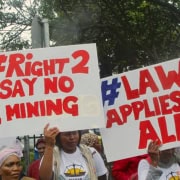|
Getting your Trinity Audio player ready...
|
By Mashudu Masutha
First published on Business Day
Development in mining-affected communities is crippled by a lack of transparency in the management and administration of benefits. Communities all over Africa live on land brimming with mineral wealth but are cheated out of benefits owed to them because of opacity, exclusion and lack of accountability in the management of trusts and other legal structures.
Corruption Watch recently released two reports focused on improving transparency and accountability in the flows of financial benefits to mining communities. These are a response to the worrying number of corruption reports received from communities most affected by mining development on their land. The reports illustrate the significant challenges they face in achieving financial and economic mobility.
The key corruption vulnerability is the lack of transparency in the management and administration of community benefits. Communities are unclear about which benefits are established on their behalf as it is almost impossible to access compensation documents. In addition, such documents are difficult for communities to understand, or there are gaps and inaccuracies in the records provided.
This systemic form of exclusion of mining communities has created a tangible risk of corruption and maladministration of benefits. Countless investigations, court judgments and research reports illustrate that opacity increases the risk of elite capture — particularly in a sector with such valuable and concentrated wealth. This in turn has a detrimental effect not only on the management of community benefits but also on the sustainability of the entire mining value chain.
Since the enactment of the Mineral and Petroleum Resources Development Act (MPRDA), which places the state as the custodian of minerals on behalf of South Africans, the mining legislative framework has prioritised transformative policies. The most evident is the Mining Charter, which progressively incorporates binding transformative targets and developmental goals linked to the awarding and retention of mining and exploration rights.
The charter sets a target that gives effect to section 100 (2)(d) of the MPRDA, for the creation of opportunities for the entry of historically disadvantaged South Africans into the industry so they can benefit from the exploitation of mineral resources. If mining companies fail to comply with this provision their mining right will be forfeited or suspended.
As a result of the charter’s binding nature and legal force, it is arguably one of the most advanced policy frameworks in the global extractive sector. Despite this, severe levels of corruption have led to many mine-affected communities languishing in poverty, deprived of development, with few prospects of upward mobility.
The unintended result of this policy agenda and the lack of its successful implementation is mining-affected communities that are not only disproportionately burdened by mining development but also disproportionately dependent on such development for access to financial mobility.
By virtue of housing mining operations or mineable minerals, communities are entitled to compensation arrangements, the structure of which depends on the type of benefit that accrues to the communities. For example, the community is entitled to rental payments from the operating mine based on a lease agreement, or compensation if individuals are relocated, or social benefits such as community halls, schools or clinics. The typical legal vehicles used to facilitate these benefits are non-profit companies and communal property associations where land is awarded as part of the benefit.
For the above-mentioned benefits, and specifically for equity payments, the most prominent legal vehicle used is community trusts. Corruption Watch found that community trusts are susceptible to high levels of abuse and mismanagement, which leads to funds not trickling down to those most affected. The Trust Property Control Act, the legislation that governs trusts, neither defines nor addresses community trusts as a special form of trust, or one requiring specific transparency and accountability mechanisms. Therefore, unless a trust is drafted specifically to safeguard the interests of its beneficiaries it can be used for illicit means, to the detriment of communities.
The report of the Baloyi commission of inquiry into the Bakgatla ba Kgafela traditional community is a key example of the transparency weaknesses of community trusts. The Baloyi report illustrates how traditional leaders, mining companies, public officials, lawyers and consultants can conclude compensation arrangements on behalf of communities to loot large amounts of money for private gain — money intended to provide benefits and financial mobility to the community.
The Bakgatla ba Kgafela community is not a novel case. Mining communities across the country are impoverished, with doubtful prospects of wealth and opportunity despite housing the world’s most valuable commodities.
Economists and those involved in development use the term “resource curse” to refer to the discovery and extraction of oil and other natural resources that is accompanied by an imbalance between sustainability, development, prosperity and opportunity. This paradox is synonymous with many African mineral-rich jurisdictions, with extreme poverty and poor development, especially those countries in which oil and minerals play a major economic role.
A key enabler of the resource curse is corruption, and the large-scale stealing of community funds at the hands of public officials, traditional leaders and industry representatives is the most chilling example of this reality. The systemic looting of community funds will continue unless policymakers, oversight bodies and industry giants set the tone by significantly shifting their priorities to transparency and accountability in the management and administration of flows of community benefits.
Strong, evidence-driven data supports the argument that the looting machinery in community benefits has embedded itself deep within governance processes by key stakeholders. However, Corruption Watch puts forward an equally strong argument of incorporating a transparency and accountability lens in policymaking, and industry standards of best practice in the management of community benefits, for sustainability.
The influential few are profiting privately from lucrative compensation arrangements that should benefit those most affected by mining developments. Transparency is an important antidote for such elite and state capture, particularly if complemented with accountability and the rule of law.
But transparency on its own is not a silver bullet. The starting point should be knowledge of who the beneficiaries are, and the type of benefit and amount of money to which communities are entitled, made easily accessible to all relevant stakeholders through the disclosure of relevant timely, and reliable information.
Masutha is legal researcher: extractives at Corruption Watch.








